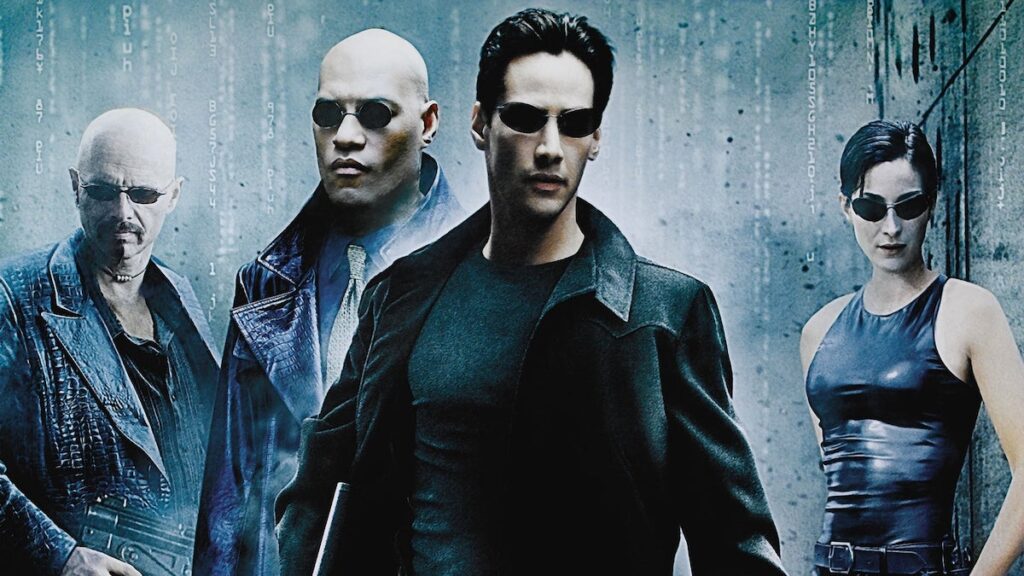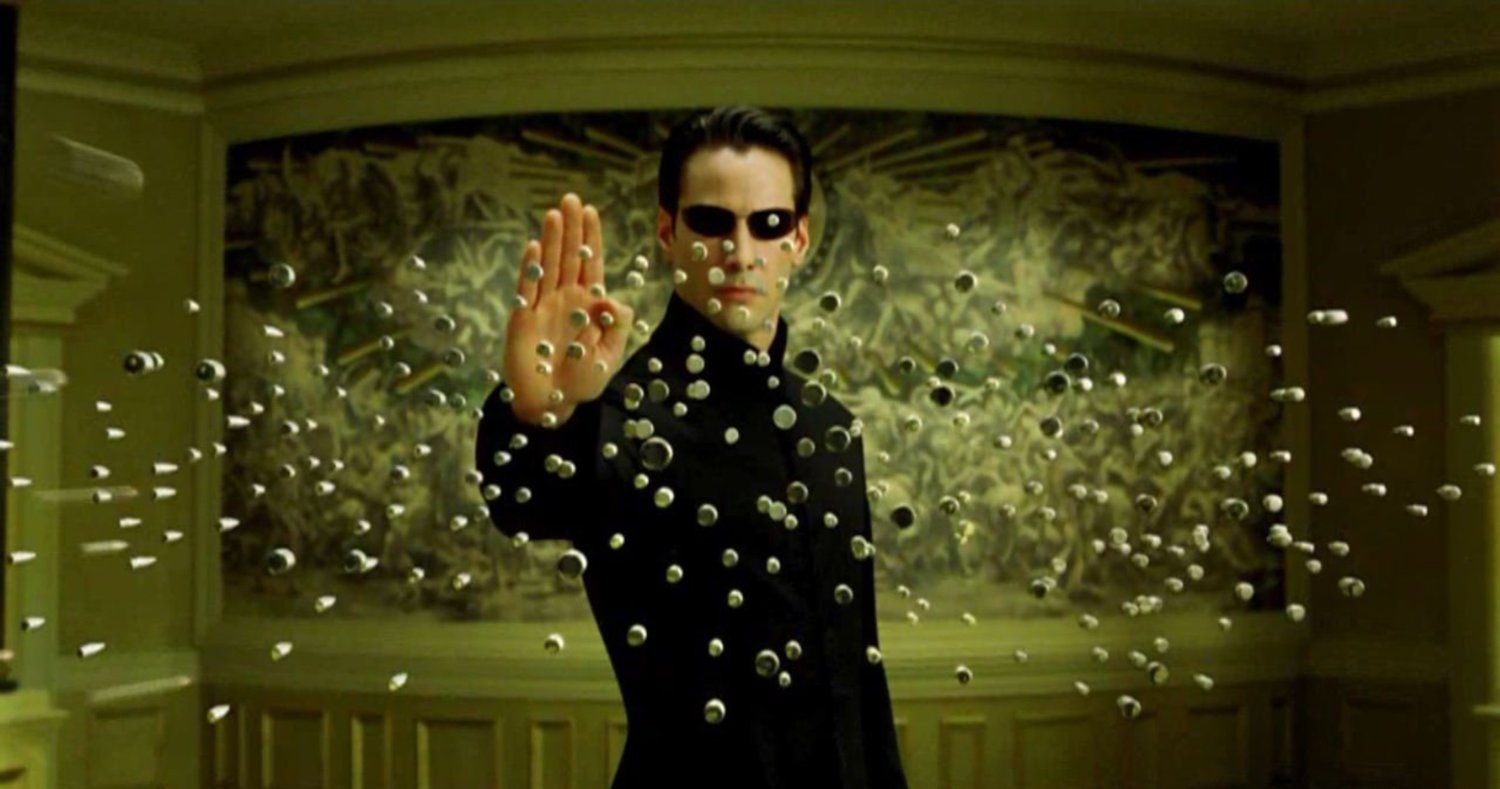15 Interesting Facts :-
Conceptual Origins: The Wachowskis, creators of The Matrix, were inspired by a variety of sources, including philosophy (like Descartes’ “Evil Genius” concept), anime, cyberpunk literature, and martial arts films.
Bullet Time Innovation: The film popularized “bullet time” cinematography, where the action appears to freeze while the camera moves around it. This effect was achieved through a combination of time-slicing photography and computer-generated imagery (CGI).
Kung Fu Training: To prepare for their roles, actors Keanu Reeves, Laurence Fishburne, Carrie-Anne Moss, and Hugo Weaving underwent extensive martial arts training for several months.
Black Leather Fashion: The iconic black leather outfits worn by the main characters became a trademark of the film and influenced fashion trends in the late 1990s and early 2000s.
Code Rain: The distinctive “code rain” visual effect, consisting of cascading green characters representing the Matrix’s digital environment, was inspired by Japanese sushi recipes and the complex characters of Kanji and Katakana.
Red and Blue Pills: The choice between the red pill and the blue pill has become a popular cultural metaphor for choosing between ignorance and knowledge. Taking the red pill signifies a willingness to confront reality, while the blue pill represents remaining in blissful ignorance.
Neo’s Real Name: Neo’s original name, Thomas A. Anderson, is an homage to comic book characters: Thomas from “Tom Anderson” (a.k.a. “Tom of Finland,” an influential artist in gay erotic comics) and Anderson from DC Comics’ Superman alias Clark Kent.
The Oracle’s Role: The character of the Oracle was originally meant to be portrayed by actress Jeanne Tripplehorn but scheduling conflicts led to casting Gloria Foster instead, which ultimately became an iconic portrayal.
Innovative Camera Techniques: The “bullet time” effect was achieved using an array of still cameras placed around the subject and triggered in quick succession. This technique required innovative camera and computer coordination.
Matrix Reloaded Highway Scene: The freeway chase scene in The Matrix Reloaded involved the construction of over a mile of freeway in California, making it one of the most expensive action sequences ever filmed at the time.
Morpheus’ Sunglasses: Morpheus’ distinctive sunglasses, worn throughout the trilogy, were custom-made by a Japanese eyewear designer, and their sleek design contributed to his iconic look.
The Matrix Code: The iconic green digital rain of falling characters seen in the film represents the encoded structure of the simulated reality of the Matrix.
Agent Smith’s Evolution: Agent Smith’s character undergoes significant development throughout the trilogy, transforming from a standard program into a virus-like entity with his own agenda and desires.
Matrix Philosophy: The film delves into philosophical concepts such as reality, free will, determinism, and the nature of existence, drawing heavily from works like Plato’s “Allegory of the Cave” and Baudrillard’s “Simulacra and Simulation.”
Matrix Trilogy Impact: Beyond its box office success, The Matrix trilogy has had a lasting impact on popular culture, inspiring numerous parodies, video games, spin-off media, and discussions about technology, reality, and consciousness.

Released Date: March 31, 1999
Genre: Science Fiction, Action
Detail Plot: The Matrix follows Neo (Keanu Reeves), a computer programmer who discovers the shocking truth about his reality and becomes embroiled in a rebellion against sentient machines that have enslaved humanity within a simulated reality.
Cast: Keanu Reeves, Laurence Fishburne, Carrie-Anne Moss, Hugo Weaving
Crew: Directed by The Wachowskis, Produced by Joel Silver, Written by The Wachowskis
Public Rating: 8.7/10 on IMDb
Reviews: Critically acclaimed for its groundbreaking visual effects, philosophical themes, and intense action sequences.
Trivia: The iconic bullet-dodging scene was achieved using a technique called “bullet time,” which involved an array of still cameras capturing motion from different angles simultaneously.
Notable Quotes: “Welcome to the real world.” – Morpheus
Budget and Box Office collection: Budget – $63 million, Box Office – $463.5 million
Awards: Won 4 Oscars including Best Visual Effects, Nominated for 4 additional Oscars including Best Picture
Nominations: Numerous awards and nominations for its innovative filmmaking and cultural impact.
Behind the scenes stories.
The making of The Matrix was a journey filled with innovation, dedication, and a relentless pursuit of perfection. From the visionary minds of the Wachowskis to the tireless efforts of the cast and crew, every aspect of the production was meticulously crafted to bring this dystopian world to life.
One of the most notable aspects of the film’s production was its groundbreaking visual effects. The Wachowskis pushed the boundaries of technology, introducing audiences to the revolutionary “bullet time” technique that allowed for seemingly impossible action sequences. This involved a complex array of cameras capturing motion from multiple angles simultaneously, creating the illusion of frozen time as characters dodged bullets with superhuman agility.
Production Challenges
However, with innovation comes challenge, and The Matrix was no exception. The ambitious nature of the film’s action sequences pushed the limits of practical effects, requiring months of meticulous planning and execution. From the intricate choreography of fight scenes to the construction of elaborate sets, every aspect of the production demanded precision and attention to detail.
One of the most memorable challenges faced during filming was Carrie-Anne Moss’s injury while shooting a fight scene. Despite fracturing her leg, Moss persevered, demonstrating an unwavering commitment to her role as Trinity. Her dedication, along with that of her fellow cast members, exemplified the passion and determination that fueled the production of The Matrix.
Accidents and Anecdotes
Of course, no production is without its share of accidents and anecdotes, and The Matrix was no different. From on-set mishaps to moments of unexpected inspiration, the journey to bring this visionary world to life was filled with twists and turns.
One particularly memorable anecdote involves Hugo Weaving, who portrayed the iconic villain Agent Smith. In preparation for his role, Weaving drew inspiration from the distinct voice of filmmaker Hal Hartley, crafting a performance that would become synonymous with the character. His meticulous approach to the role exemplifies the level of detail and commitment that defined the production of The Matrix.

